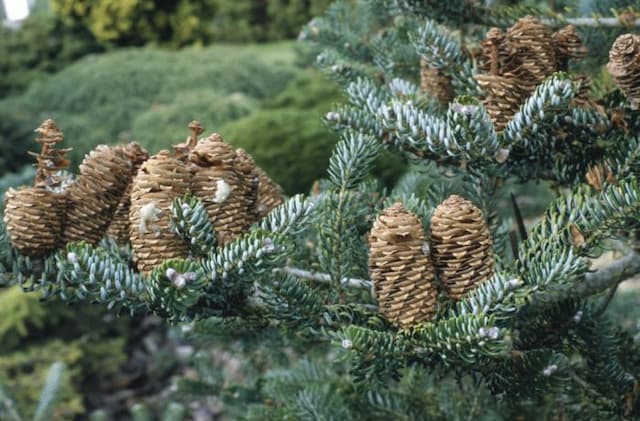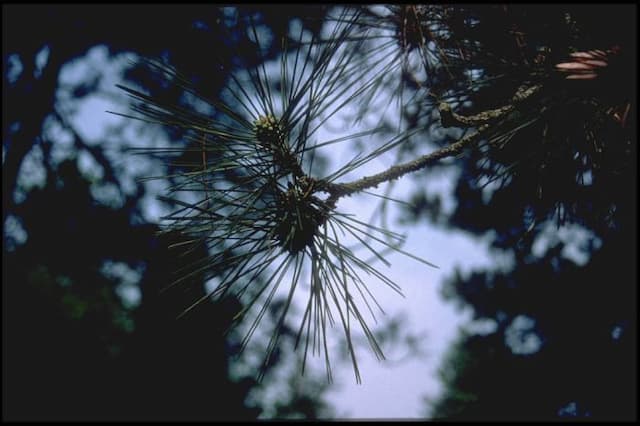Hudson fir 'Hudsonia' Abies balsamea (Hudsonia Group) 'Hudsonia'

ABOUT
'Hudsonia' is a dwarf cultivar, making a low rounded mound. Distinctively arranged dark green needle-like leaves, to 1.5cm long. are whiteish beneath. No cones are produced
About this plant
 Names
NamesFamily
Pinaceae.
Synonyms
Balsam Fir, Eastern Fir, Blister Fir, Bracted Balsam Fir, Canadian Balsam, Hudsonia Balsam Fir.
Common names
Abies balsamea (Hudsonia Group) 'Hudsonia'.
 Characteristics
CharacteristicsLife cycle
Perennials
Foliage type
Evergreen
Color of leaves
Green
Height
40-60 feet (12-18 meters)
Spread
20-25 feet (6-7.6 meters)
Plant type
Tree
Hardiness zones
3-5
Native area
North America
Benefits
 General Benefits
General Benefits- Ornamental Appeal: The 'Hudsonia' Balsam Fir has a naturally symmetrical conical shape that adds aesthetic value to landscapes.
- Wildlife Habitat: Provides shelter and nesting sites for birds and other wildlife.
- Adaptability: It is tolerant to a range of soil types, though it prefers moist, well-drained acidic soils.
- Cold Hardy: This plant is able to withstand the cold temperatures of northern climates.
- Evergreen Foliage: Retains its needles throughout the year, offering constant greenery.
- Christmas Tree Use: Often used as a Christmas tree because of its shape, fragrance, and needle retention.
- Fragrance: The needles and resin of the Balsam Fir have a pleasant scent that can freshen up the atmosphere around it.
- Compact Growth: Smaller than many other fir trees, making it suitable for smaller landscape areas or gardens.
- Low Maintenance: Requires relatively low maintenance once established in an appropriate site.
 Medical Properties
Medical Properties- Antiseptic - The resin, commonly known as balsam fir pitch, has been used for its antiseptic properties to treat cuts and wounds.
- Analgesic - An oil distilled from the needles has been traditionally used to relieve pain, particularly muscular and joint pain.
- Anti-inflammatory - Balsam fir has been used in folk medicine to reduce inflammation.
- Expectorant - The plant has been used to help with respiratory issues by loosening mucus and easing coughs.
- Aromatherapy - Essential oils from balsam fir are used in aromatherapy for their soothing and relaxing scent.
 Air-purifying Qualities
Air-purifying QualitiesThis plant is not specifically known for air purifying qualities.
 Other Uses
Other Uses- Crafting Material: The wood of the Balsam Fir is soft and can be used for crafting small wooden items like ornaments and intricate carvings.
- Scented Products: The aromatic resin is used in making perfumes, scented candles, and air fresheners, providing a natural forest fragrance.
- Photography: The sticky resin can be used as an adhesive for mounting specimens in microscopic slides.
- Waterproofing: The resin from Balsam Fir, known as Canada balsam, was historically used to waterproof seams in canoes and other boats.
- Specialty Inks: The resin may be used in the formulation of certain printing inks, especially where a degree of tackiness is required.
- Microscopy: Canada balsam, derived from the tree’s resin, is used as a mounting medium for microscope specimens.
- Christmas Tradition: Balsam Fir is a popular Christmas tree due to its pleasant scent and symmetrical shape.
- Bird Habitat: These trees provide natural habitat and nesting sites for birds such as crossbills and chickadees.
- Artistic Inspirations: Balsam Fir landscapes are often used as subjects in paintings and photography, capturing the essence of evergreen forests.
- Educational Tool: The tree and its growth patterns are used to teach about coniferous trees and ecosystems in educational settings.
Interesting Facts
 Feng Shui
Feng ShuiThe Balsam Fir is not used in Feng Shui practice.
 Zodiac Sign Compitability
Zodiac Sign CompitabilityThe Balsam Fir is not used in astrology practice.
 Plant Symbolism
Plant Symbolism- Resilience: Balsam Fir, as an evergreen tree, symbolizes resilience for its ability to endure cold winters and remain green throughout the year.
- Endurance: The hardiness of the Balsam Fir represents the strength to persevere through challenges and tough conditions.
- Purity: Known for its clean, fresh scent, the Balsam Fir can denote purity and the cleansing of the spirit.
- Healing: Given the tree's traditional use in medicine for its balsamic properties, it represents healing and rejuvenation.
- Peace: The Balsam Fir's evergreen nature and tranquil forest presence often symbolizes peace and tranquility.
 Water
WaterThe Balsam Fir should be watered deeply and regularly during its first growing season to establish an extensive root system. After establishment, adjust watering to keep the soil consistently moist but not waterlogged. During the growing season, typical watering might be around 1 inch of water per week, either from rainfall or manual watering. In the absence of rain, provide about 1-2 gallons per week for young trees, and for mature trees, increase the amount to account for their larger root systems. During hot or windy weather, water more frequently; during winter, reduce watering but do not let the tree dry out completely.
 Light
LightBalsam Fir prefers full sun to partial shade. The ideal spot would be in a location where it receives at least six hours of direct sunlight each day. However, it can tolerate some light shade, especially in hotter climates. Avoid placing it in deep shade as this can lead to poor growth and reduced vigor.
 Temperature
TemperatureBalsam Fir thrives in cooler climates and can withstand temperatures down to about -40 degrees Fahrenheit, making it very cold-hardy. Its ideal growing temperature is between 40 and 70 degrees Fahrenheit. Extreme heat above 90 degrees Fahrenheit can be detrimental to the tree, especially if combined with drought conditions.
 Pruning
PruningPruning Balsam Fir is generally done to shape the tree, remove dead or damaged branches, and maintain tree health. The best time to prune is late winter or early spring before new growth starts. Pruning should be minimal and can be done every 2 to 3 years, focusing only on necessary cuts to avoid stimulating excessive growth. During the holiday season, moderate pruning can be done for those using it as a Christmas tree.
 Cleaning
CleaningNot needed
 Soil
SoilBalsam Fir 'Hudsonia' thrives best in a well-draining soil mix of loam, sand, and organic matter with a pH range of 5.5 to 7.0, ensuring adequate moisture retention and root aeration.
 Repotting
RepottingBalsam Fir 'Hudsonia' generally does not require frequent repotting and should be repotted sparingly, ideally only when it has outgrown its container, which for mature trees is rare due to their size.
 Humidity & Misting
Humidity & MistingBalsam Fir 'Hudsonia' prefers moderate to high humidity levels but can tolerate lower humidity typical of outdoor environments.
 Suitable locations
Suitable locationsIndoor
Provide bright light, cool temps, and water moderately.
Outdoor
Needs full sun, well-draining soil, space to grow.
Hardiness zone
3-7 USDA
 Life cycle
Life cycleAbies balsamea, commonly known as Balsam Fir or Hudsonia Balsam Fir when referring to the 'Hudsonia' cultivar, begins its life cycle with seed germination, typically occurring in spring as temperatures rise and the snow melts. The seeds sprout into seedlings, which gradually develop into saplings in a process that depends heavily on sufficient sunlight, water, and nutrients. As the saplings mature into young trees over several years, they undergo a period of rapid growth, establishing a strong root system and a sturdy, conical shape characteristic of the species. Upon reaching maturity, which can take 15 years or more, Balsam Fir trees begin producing cones; the female cones are upright and grow near the top of the tree, while male cones are lower down and release pollen to fertilize the female cones. Pollinated cones develop seeds that are dispersed by the wind, potentially colonizing new areas and beginning the life cycle anew. The Balsam Fir can live for 150 years or longer, with mature trees eventually declining and dying, providing habitat and nutrients for a host of forest organisms as part of the ecosystem's nutrient cycle.
 Propogation
PropogationPropogation time
Late Summer
The most popular method for propagating Balsam Fir, which includes the Abies balsamea (Hudsonia Group) 'Hudsonia', is by seed. The best time to collect seeds is in late summer or early fall, when the cones have matured but have not yet opened. The seeds can be extracted by drying the cones in a warm, dry place until they open naturally. Once collected, seeds should be stored in a cool, dry location until sowing. Sowing typically occurs in spring, after a period of cold stratification for roughly 1-2 months to break seed dormancy. This can be done by placing seeds in a sealed container with moist sand or peat and refrigerating it. When sowing, seeds are lightly covered with soil and should be kept consistently moist until germination, which usually occurs within a few weeks to a couple of months.









